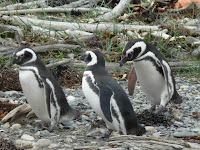 |
| The end of the world - Ushuaia |
 |
| Sea Lions |
We visited an Estancia (ranch) that was established by a British missionary in the 1800's, complete with English gardens! The most
 |
| only 13400km to London! |
There was a gruesome workshop where a couple of workers were stripping fat from Whale bones using a vat of acid and knives, and a couple of freshly skinned Dolphin heads. The museum was impressive, displaying many remains of enormous Whales alongside Dolphins and Sea lions.
We had an extra half day in Ushuaia as our flights back to Buenos Aires where delayed by a few hours so took a trek up one of the ski runs (no snow) to get a view of the town but the visibility was poor . It also started snowing so we cut it short.
One thing about Ushuaia is the weather changes in an instant - sunny, then suddenly its raining, then snowing.
 |
| On mountain outside Ushuaia |
Its interesting that nearly every South American i spoke to about football loved the Premiership and said it was there favourite league, more than the Spanish league because its more exciting to watch.
We had a couple more days left and had exhausted Buenos Aires, so we took a ferry for the short hop over to Uruguay. We arrived in Colonia then took a bus to the capital Montevideo and visited an Aunt of Emmas who has lived there for several years teaching English. Montevideo is a pleasant city, far smaller than Buenos Aires and has a friendlier, small town feeling about it. We went out for Steak and a large quantity of Red Wine.
 |
| Plaza, Colonia in Uruguay |
We spent the final night in Buenos Aires and went to see a tango show. It was fairly enjoyable. I really liked the actual Tango bits but it turned into bit of an all round Argentina theme show. There was an annoying cowboy/indian bit (dressed as gauchos, playing ubiquitous "ethnic" pan pipe music same as you hear everywhere in Peru and Bolivia) and renditions of My Way (in spanish) and Don't cry for me Argentina (surprise!!).
So that is the end of the trip. Its been really amazing, as enjoyable and exciting as i hoped it would be. I met some great people, saw some stunning scenery, had some adventure, learnt to speak spanish (to a degree!).
Its scratched a huge itch on one level, but you meet so many people that talk about how wonderful other countries are that they have visited, you find your travel wishlist lengthening not shortening.
Having said that, i was looking forward to coming home. I felt surprisingly happy as i saw England for the first time in 14 weeks as we descended into heathrow.
Its late November, and its cold, wet, and dark but what can you do? Its home.
Bring on the curry!



















































